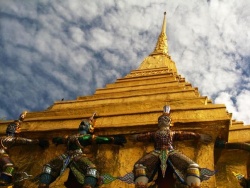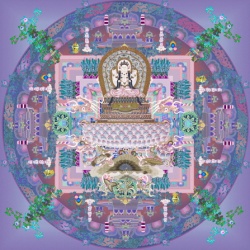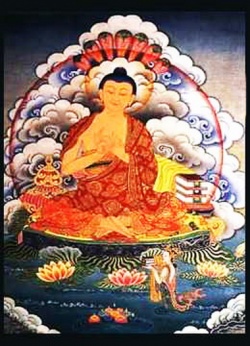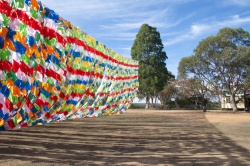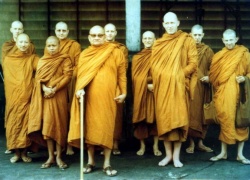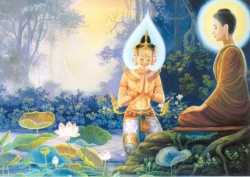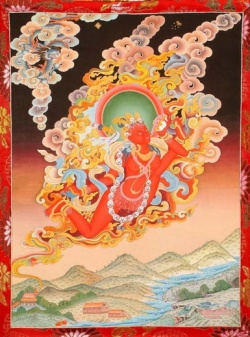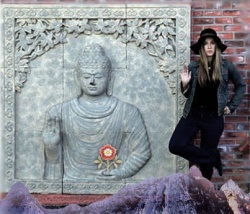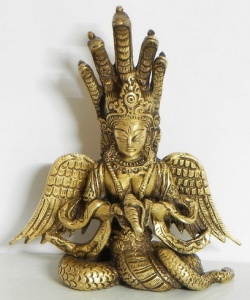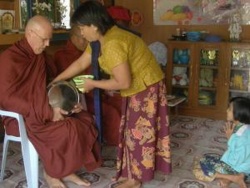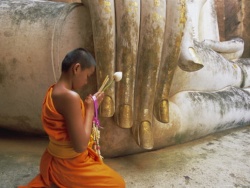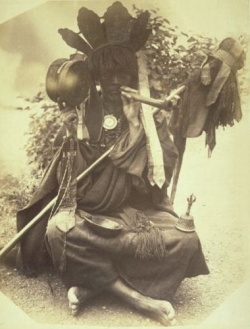The Use of Entheogens in the Vajrayana Tradition: a brief summary of preliminary findings together with a partial bibliography.
by R.C. Parker (updated 2008)
Warning: datura is an extremely powerful and dangerous hallucinogen. In addition to the dangers inherent in severe hallucinosis, the plant is quite toxic. There have been reports of coma and death resulting from this toxicity.
The broad definition of entheogen used here is: "plants or substances capable of producing visionary experiences which are used for magico-religious or psychospiritual purposes."
The use of entheogens in the Vajrayana tradition has been documented by such scholars as Ronald M Davidson, William George Stablein, Bulcsu Siklos, David B. Gray, Benoytosh Bhattacharyya, Shashibhusan Das Gupta, Francesca Fremantle, Shinichi Tsuda, David Gordon White, Rene de Nebesky-Wojkowitz, James Francis Hartzell,
Edward Todd Fenner, Ian Baker, Dr. Pasang Yonten Arya and numerous others.
The research of these scholars has established that these plants were definitely used in Vajrayana (within limited contexts) and that they were used in a manner largely consistent with their use in Saivite and shamanic traditions.
This investigation has focused primarily on the use of entheogens in the anuttara-yoga-tantra materials especially (but not exclusively) the Yogini-tantras.
The research has centered on the use of datura and cannabis (which are consider entheogenic plants despite the fact that neither is a "classical psychedelic").
The findings that have the most immediately obvious significance are the numerous references to pills, siddhi-drugs, and rasayana elixirs that contain either datura or cannabis. (Stablein 1976, Baker 2004, Gray. 2007, Walter 1986, Fenner 1979, Dash 1988, Arya 1998)
The importance of ointments and homa-rituals making use of datura is not as readily apparent. Davidson has commented on these noting that datura was “employed as a narcotic paste or as wood in a fire ceremony and could be easily absorbed through the skin or the lungs.
The seeds of this powerful narcotic, termed "passion seeds" (candabija), are the strongest elements and contain the alkaloids hyoscine, hyoscyamine, and atropine in forms that survive burning or boiling.
In even moderate doses, datura can render a person virtually immobile with severe belladonna-like hallucinations.”
Numerous references were found to the use of datura in ointments (Stablein 1976, Baker 2004, Hartzell 1991, Davidson 2002).
Homa-rituals making use of datura were found to be quite common (Gray 2007, Siklos 1993 & 1996, Tsuda 1974, Fremantle 1971, Nebesky-Wojkowitz 1956, Hartzell 1991, Davidson 2002).
Also found was a detailed meditation on the drug-induced visionary experience as a method to gain insight into the nature of reality (Stearns 2006).
Generally speaking, the references that have been located originate in sources that can be divided into three categories:
1) Primary Literature (numerous primary and secondary tantras, original Indian commentaries, and the stories and songs related to the Indian tantric mahasiddhas)
2) Secondary Literature (rituals texts of Tibetan or Newar origin, various gter-ma or "treasure texts", as well as Tibetan commentarial literature)
3) Modern Ethnological Research (studies by researchers such as anthropologist and ethnologists which document the use of entheogens within the living traditions of Vajrayana among the Nepalese, Tibetans, Bhutanese etc)
1) A number of the "major" tantras within the Vajrayana tradition specifically mention entheogens (datura and/or cannabis) and their use.
<poem>
These include:
the Laghusamvara-tantra (aka Chakrasamvara-tantra),
Samputa-tantra,
Samvarodaya-tantra,
Mahakala-tantra,
Guhyasamaja-tantra,
Vajramahabhairava-tantra, and the
Krsnayamari-tantra.
Relevant material can also be found in the Candamaharosana-tantra and the Caturpitha-tantra.
There are a number of tantras of secondary importance (within the Indo-Tibetan tantric traditions) that mention entheogens such as Amrtakalasa-tantra, Tara-tantra and the Anuttaratara-tantra.
Of course, mentions of entheogens can also be found in commentaries on the tantras.
Interestingly, some commentaries to tantras will mention the use of specific entheogens even when the tantra itself does not;
examples of this are Vajragarbha's Dasasahasrika-Hevajra-tika (a Hevajra commentary) and Pundarika's Vimalaprabha (the main commentary to the Kalachakra-tantra).
Included in what is considered the "primary literature" are the traditional stories and songs relating to the tantric mahasiddhas.
These include such standard Vajrayana texts as the Caturasiti-siddha-pravrtti and the Carya-giti-kosa-vrtti.
Also included are sources of stories and songs relating to the mahasiddhas from the Indian vernacular literature such as the Gopicander-Sannyas (although it could be argued that these vernacular sources are best grouped amongst the "secondary literature")
2) The Tibetan and Newar literature mentioning entheogens.
This includes the Tibetan commentarial literature (for instance lam 'bras texts from the sa skya tradition such as _dpal sa skya pa'i lam 'bras kyi chos gces btus]]_).
Although they are usually said to be the work of early Indic visitors to Tibet, I classify the Tibetan "treasure literature" as secondary texts of Tibetan origin.
An example of a "treasure text" that includes formulas for pills and ointments containing datura is the _bi ma snying thig_.
Of course it goes without saying that commentaries on the "treasure literature" (which mention entheogens) such as Longchenpa's _snying thig ya bzhi_ or Jigmed Tenpa'i Nyima's _gter gyi rnam bshad_ are included as secondary texts.
Ritual texts would also fall into what I consider the secondary literature.
3) A number of anthropologists, ethnologists, and ethnobotanists have documented the use of entheogens within the living traditions of Vajrayana practiced in Nepal and to a lesser extent Tibet and Bhutan.
When these sources are taken together, their combined weight leaves little room for doubt that Vajrayana has had a well-documented tradition of making use of entheogenic plants (especially datura and cannabis) for magico-religious and psychospiritual purposes. While this use may never have been particularly widespread, it is certainly significant.
Partial Bibliographic List of Resources
It is unfortunate that many of the references to entheogens in the below literature amount to only a couple of sentences buried deep within a scholarly text dedicated to other subjects.
Very few of these resources contain a sustained discussion of these plants and their significance in Vajrayana.
It is hoped that, in the future, this topic willed receive a more thorough treatment.
Vajrayana and the use of datura and cannabis
David B. Gray. 2007, The Cakrasamvara Tantra (The Discourse of Sri Heruka) A Study and Annotated Translation (cannabis and datura)
William George Stablein 1976, The Mahakalatantra: A theory of ritual blessings and tantric medicine Doctoral Dissertation, Columbia University (datura in pills and ointments, cannabis, betel, and other psychoactive plants)
Bulcsu Siklos 1996, The Vajrabhairava Tantras (datura and possibly cannabis)
Shinichi Tsuda 1974, The Samvarodaya-Tantra: Selected Chapters. Tokyo: The Hokuseido Press. (datura, betel and possibly cannabis)
Francesca Fremantle 1971, A Critical Study of the Guhyasamaja Tantra. Doctoral Dissertation University of London (datura)
Michael Walter 1986, The Tantra a Vessel of bdud rtsi: a Bon text published in Journal of the Tibet Society 1987 Vol. 8 pgs 25-72 (cannabis, betel, and other psychoactive plants)
Malati J Shendge 2004, Satsahasrika-Hevajra Tika (datura?)
Cyrus Stearns 2006. Taking the Result as the Path: Core Teachings of the Sakya Lamdre Tradition (datura)
Rene de Nebesky-Wojkowitz 1956, Oracles and Demons of Tibet - The Cult and Iconography of the Tibetan Protective Dieties (datura and cannabis)
James Francis Hartzell 1991,Tantric Yoga: A Study of the Vedic Precursors, Historical Evolution, Literatures, Cultures, Doctrines, and Practices of the llth Century Kasmiri Saivite and Buddhist Unexcelled Tantric Yogas Doctoral Dissertation, Columbia University (datura in the Vimalaprabha [[[homa]]) and the Krsnayamari-tantra [ointment])
Edward Todd Fenner 1979, Rasayana-Siddhi: Medicine and Alchemy in the Buddhist Tantras Doctoral Dissertation University of Wisconsin-Madison (datura in the Vimalaprabha’s rasayana siddhi medicines)
Ronald M Davidson 2002, Indian Esoteric Buddhism: a social history of the Tantric movement (datura and betel)
Bulcsu Siklos 1993, Datura Rituals in the Vajramahabhairava Tantra published in Curare Vol 16 (1993) pgs 71-76 (datura)
William Stabtein 1976, "Mahakala the Neo-Shaman: Master of the Ritual" published in Spirit Possession in the Nepal Himalayas. John T. Hitchcock and Rex L. Jones, eds,, pp. 361-375. (datura)
Tulku Thondup Rinpoche 1997, Hidden Teachings of Tibet (datura)
Ian Baker 2004, The Heart of the World, (datura in the Vima Nyingthig and the Nyingthig Yabzhi)
Dr. Pasang Yonten Arya 1998, Dictionary of Tibetan Materia Medica (mentions the use of cannabis as a rasayana type elixir in a Tibetan tantra related to the goddess Tara)
Vaidya Bhagwan Dash 1988, Formulary of Tibetan Medicine (contains a number of rasayana derived “mercurial medicines” containing cannabis and one with datura)
Lama Zopa Rinpoche 1974, Kopan Course No. 7 (datura)
Girish Chandra Vedantatirtha ed. 1914, Tara Tantra. Tara-Tantram, With an Introduction by A. K. Maitra. (cannabis)
Siddha stories and songs
Keith Dowman 1985, Masters of Mahamudra; Songs and Histories of the Eighty-Four Buddhist Siddhas (cannabis and datura)
Benoytosh Bhattacharyya 1931, An Introduction to Buddhist Esoterism (cannabis and datura)
Shashibhusan Das Gupta 1976, Obscure Religious Cults, (cannabis and datura)
David Gordon White 1996, The Alchemical Body: Siddha Traditions in Medieval India. (cannabis)
Ann Grodzins Gold 1992, A Carnival of Parting, The Tales of King Bharthari and King Gopi-Chand as Sung and told by Madhu Natisar Nath of Ghatiyali, Rajasthan / Translated with an Introduction and Afterword by Ann Grodzins Gold (cannabis)
Keith Dowman 1988, Masters of Enchantment (datura)
Lalit Tiwari (undated), Siddha Medicine: Its Basic Concepts (cannabis associated with the mahasiddha Goraksa)
Mike Crowley 2007 personal communication
Datura visions and insight into the illusory nature of reality
Cyrus Stearns 2006. Taking the Result as the Path: Core Teachings of the Sakya Lamdre Tradition (datura)
Herbert V. Guenther 1976, Kindly Bent to Ease Us: Wonderment (datura)
Tulku Thonlop Rinpoche 1989, Buddha Mind: An Anthology of Lonchen Rabjam’s Wrtings on Dzogpa Chenpo
Dudjom Rinpoche 1991, The Nyingma School of Tibetan Buddhism: Its Fundamentals and History (datura)
Longchenpa (undated), The Commentary On The Great Perfectione Nature Of Mind, The Easer Of Weariness Called The Great Chariot (datura)
Tulku Urgyen Rinpoche 2006, Repeating the words of the Buddha (datura)
Robert Thurman 1995, Essential Tibetan Buddhism (datura)
Elías Capriles 2006, Beyond Being Beyond Mind, Beyond History: A Dzogchen founded meta-transpersonal, meta-postmodern philosophy and psychology for survival and an age of communion (datura)
Keith Dowman 1988, Masters of Enchantment (datura)
Keith Dowman 1985, Masters of Mahamudra; Songs and Histories of the Eighty-Four Buddhist Siddhas (cannabis and datura)
Chikyo Yamamoto 1990, Mahavairocana Sutra (siddhi drugs and unspecified hallucinogens)
Relevant ethnological or ethnobotanital research relating to the use of cannabis
Sami Kivelä 2005, The Sarced Hilltop: A Hermeneutical Case Study on the Svayambhu Site in Kathmandu. Master’s thesis, University of Helsinki. (cannabis and betel)
Rene de Nebesky-Wojkowitz 1956, Oracles and Demons of Tibet - The Cult and Iconography of the Tibetan Protective Dieties (datura and cannabis)
Mia Touw 1981, The religious and medicinal uses of Cannabis in China, India and Tibet published in Journal of Psychoactive Drugs 13: 23-34 (cannabis)
G. K. Sharma 1977, Cannabis Folklore in the Himalayas published in Harvard Botanical Museum Leaflets Vol. 25 No.7 (cannabis)
G.K. Sharma, 1977, Ethnobotany and its significance for Cannabis studies in the Himalayas published in Journal of Psychedelic Drugs Vol. 9(4): 537-339. (cannabis)
Christian Rätsch 2000, Shamanism and Tantra in the Himalayas (information on cannabis, datura, and betel etc in Himalayan traditions)
Christian Rätsch, 1998, Marijuana Medicine (cannabis)
Richard Evans Schultes and Albert Hofmann 1992, Plants of the Gods pgs 97-98. (cannabis)
Michael R. Aldrich 1977, Tantric Cannabis Use in India published in Journal of Psychedelic Drugs Vol. 9 (Jul-Sep) No.3 pgs 227-233 (cannabis)
Miscellaneous
Giuseppe Tucci 1980, The Religions of Tibet. English translation by Geoffrey Samuel (unspecified intoxicating plants)
John A Ardussi 1977, Brewing and Drinking the Beer of Enlightenment in Tibetan Buddhism: The Doha Tradition published in Tibet Journal of the American Oriental Society, Vol. 97 No. 2 pgs 115-124 (ointments for siddhis)
Pan-Indian Yogic tradition and the use of cannabis and datura
Frits Staal 1975, Exploring Mysticism (cannabis and datura)
Pratricia J Morningstar 1985, Thandai and Chilam: Traditional beliefs about the proper uses of Cannabis published in Journal of Psychoactive Drugs 17(3) pgs 141-165
Michael R. Aldrich 1977, Tantric Cannabis Use in India published in Journal of Psychedelic Drugs Vol. 9 (Jul-Sep) No.3 pgs 227-233 (cannabis)
Ethan Russo 2005, Cannabis in India: ancient lore and modern Medicine published in R. Mechoulam 2005 (ed.) Cannabinoids as Therapeutics (cannabis)
Sures Chandra Banerji 1992, New Light on Tantra (cannabis and datura)
Swami Satyananda Sawaswati 1984, Kundalini Tantra (cannabis)
Swami Satyananda Sawaswati 1984, Sure Ways to Self Realization (datura and cannabis)
Georg Feuerstein 1998, The Yoga Tradition: its history, literature, philosophy, and practice (datura and cannabis)
Agehananda Bharati 1970, The Tantric Tradition (cannabis)
Robert "Rio" Hahn 2003, Swami’s Sacred Plant, A Report of Unprecedented Datura Use In Nepal published in The Entheogen Review Vol.7 No. 1 pgs 9-14 (datura)
N. N. Bhattacharyya 2006, History of the Tantric Religion: An Historical, Ritualistic, and Philosophical Study (cannabis)
Mircea Eliade 1990, Yoga: immortality and freedom (cannabis) </poem>

